
The king eider is a large sea duck that breeds along Northern Hemisphere Arctic coasts of northeast Europe, North America and Asia. The birds spend most of the year in coastal marine ecosystems at high latitudes, and migrate to Arctic tundra to breed in June and July. They lay four to seven eggs in a scrape on the ground lined with grass and down.

Rubus spectabilis, the salmonberry, is a species of bramble in the rose family Rosaceae, native to the west coast of North America from west-central Alaska to California, inland as far as Idaho. Like many other species in the genus Rubus, the salmonberry plant bears edible fruit, typically yellow-orange or red in color, resembling raspberries in appearance.

Miltonia, abbreviated Milt. in the horticultural trade, is an orchid genus comprising twelve epiphyte species and eight natural hybrids. The miltonias are exclusively inhabitants of Brazil, except for one species whose range extends from Brazil into the northeast of Argentina and the east of Paraguay.

Senna spectabilis is a plant species of the legume family (Fabaceae) in the subfamily Caesalpinioideae native to South and Central America. They are often grown as an ornamental in front yards, parks, gardens, buildings etc. due to their bright yellow flowers that bloom during the summer months. They are also known as golden wonder tree, American cassia, popcorn tree, Cassia excelsa, golden shower tree or Archibald's cassia.

Osmunda regalis, or royal fern, is a species of deciduous fern, native to Europe, Africa and Asia, growing in woodland bogs and on the banks of streams. The species is sometimes known as flowering fern due to the appearance of its fertile fronds.
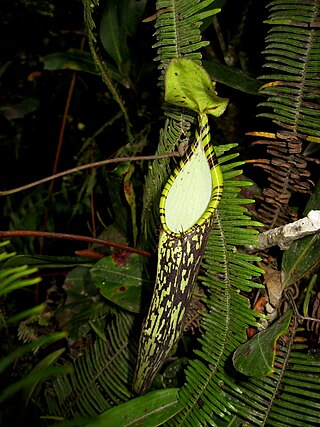
Nepenthes spectabilis is a tropical pitcher plant endemic to Sumatra, where it grows at elevations of between 1400 and 2200 m above sea level. The specific epithet spectabilis is Latin for "visible" or "notable".
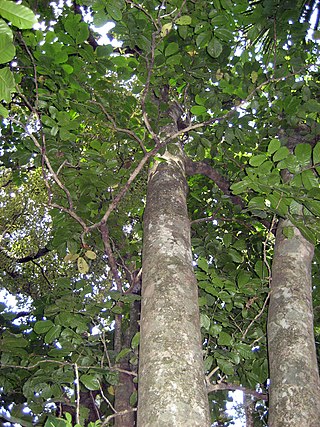
Kohekohe is a medium-sized tree in the Meliaceae family, native to New Zealand. It is found in lowland and coastal forests throughout most of the North Island and also occurs in the Marlborough Sounds in the north of the South Island. Mature trees grow up to 15 metres (49 ft) in height, with a trunk up to a metre in diameter.

Kalpaki is a former municipality in the Ioannina regional unit, Epirus, Greece. Since the 2011 local government reform it is part of the municipality Pogoni, of which it is a municipal unit. It is situated about 30 km (19 mi) northwest of Ioannina, and southwest of Konitsa. The municipal unit has an area of 116.756 km2, the community 13.189 km2. The Greek National Road 20 connects Kalpaki with Ioannina and Konitsa. The GR-22 connects Kalpaki with Kakavia, the border crossing into southern Albania.

Gymnopilus junonius is a type of mushroom-forming fungus in the family Hymenogastraceae. Commonly known as the spectacular rustgill, this large orange mushroom is typically found growing on tree stumps, logs, or tree bases. Some subspecies of this mushroom contain the neurotoxic oligoisoprenoid gymnopilin.

Gymnopilus is a genus of gilled mushrooms within the fungal family Hymenogastraceae containing over 200 rusty-orange spored mushroom species.
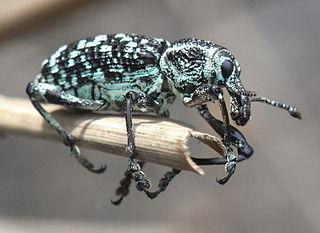
Chrysolopus spectabilis is a species of weevil found in south-eastern Australia. It was discovered during James Cook's first voyage, and became one of the first insects to be described from Australia. The weevil measures up to 25 mm (1.0 in) long and includes distinctive metallic green and black scales. It is found only on 28 species of the plant genus Acacia.

Galearis spectabilis, commonly known as showy orchis or showy orchid, is an orchid species of the genus Galearis. It is native to eastern Canada and much of the eastern half of the United States. In america they are found from eastern Oklahoma north to eastern South Dakota in the west and from Atlanta, Georgia and North Alabama north up into Maine to the east.
Ravenia is a village of Epirus, Greece located 26 km south of Ioannina at an altitude of 844 m. It belongs to the municipality of Dodoni.

The Congo serpent eagle is a species of bird of prey in the family Accipitridae. It is the only member of the monotypic genus Dryotriorchis, although it was formerly placed in Circaetus. This species is distributed across the African tropical rainforest, including upper and lower Guinean forests. This serpent eagle specializes in hunting in these forests’ dark understories. It has two subspecies, the nominate subspecies Dryotriorchis spectabilis spectabilis and Dryotriorchis spectabilis batesi. Though monotypic, it appears to be very closely related to Circaetus. This hawk is a medium-sized bird with distinctive short, rounded wings and a long, rounded tail. It is varying shades of brown on its back and has a slight crest. Its breast is white with variable amounts of a rufous wash and, in the nominate subspecies, is covered in round, blackish spots. The subspecies D. s. batesi only has these dots on its flanks. The Congo serpent eagle closely resembles Cassin's hawk-eagle, and some ornithologists believe that this likeness is a rare example of avian mimicry. It is a very vocal raptor, and often is one of the most heard species in its habitat.
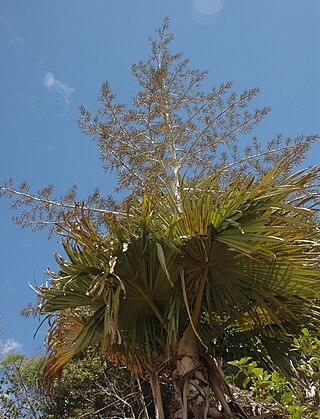
Tahina spectabilis, the tahina palm, also called blessed palm or dimaka is a species of gigantic palm that is found only in the Analalava District of northwestern Madagascar where its range is only twelve acres, one of the most extreme examples of endemism known. It can grow 18 m (59 ft) tall and has palmate leaves over 5 m (16 ft) across. The trunk is up to 20 in (51 cm) thick, and sculpted with conspicuous leaf scars. An individual tree was discovered when in flower in 2007; it was first described the following year as a result of photographs being sent to Kew Gardens in the United Kingdom for identification. The palm is thought to live for up to fifty years before producing an enormous inflorescence up to 19.5 ft (5.9 m) in height and width, surpassed in size only by Corypha spp. and by Metroxylon salomonense and, being monocarpic, subsequently dying. The inflorescence, a panicle, consists of hundreds, perhaps thousands, of three-flowered clusters which bloom in three consecutive, synchronized "cohorts" or flushes of bloom. The nearest equivalent pattern of flowering is in the flowering vine Bougainvillea where the three flowers bloom sequentially, but not synchronized. Fewer than one hundred adult individuals of the species are thought to exist and the International Union for Conservation of Nature has rated it as "critically endangered".

Malus spectabilis is a species of crabapple known by the common names Asiatic apple, Chinese crab, HaiTang and Chinese flowering apple.

Solidago spectabilis is a species of goldenrod known by the common names Nevada goldenrod, basin goldenrod, and showy goldenrod. It is native to the western United States in the Great Basin and surrounding areas. It is found in California, Arizona, Nevada, Oregon, and Utah. There are historical records saying it once grew in southwestern Idaho, but is now extirpated there. This variety has also been seen in the western Montana county of Sanders.
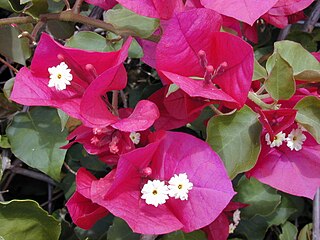
Bougainvillea spectabilis, also known as great bougainvillea, is a species of flowering plant. It is native to Brazil, Bolivia, Peru, and Argentina's Chubut Province. It is widely grown as an ornamental plant.

Ravenia is a genus of flowering plants in the citrus family, Rutaceae.


















